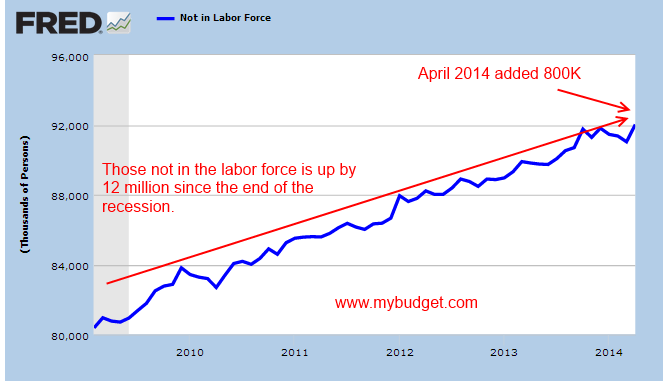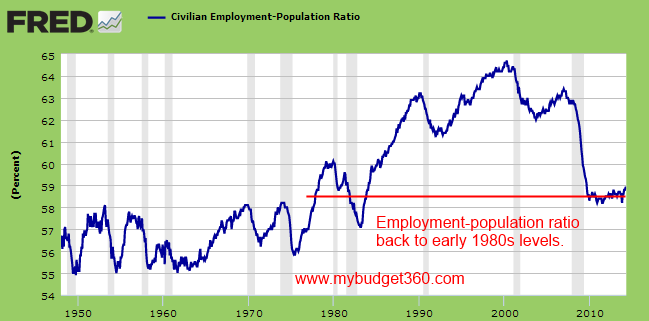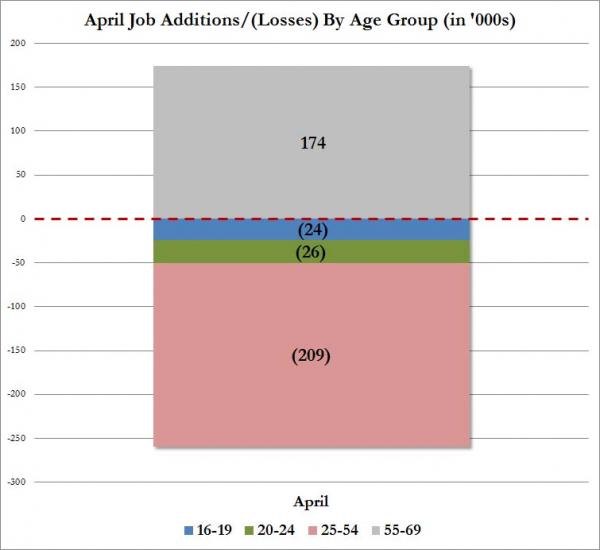The shrinking labor force
One of the more stunning figures in the monthly BLS report was that 800K Americans dropped out of the labor force. This is how we were able to get such a big dip in the unemployment rate from 6.7 to 6.3 percent. That is a massive dip and puts us back to where we were in 2008. Those not in the labor force has increased by 12 million since the recession ended, or by 15 percent. This goes again even trends of retirement for older Americans.
The shrinking labor force is a big issue because it is putting a heavy burden on the young to support an aging population. Social Security, a program that is already fragile will need younger workers employed to make payments to those on it.
Take a look at the “not in the labor force” growth:

This is why after digging through the employment report, the drop in the unemployment rate was nothing more than having a giant amount of Americans not being counted in the labor force. Yet this is a trend that is ignored by the press. Yes, it is a trend since we have expanded this category from 80 million in 2008 when the recession ended to 92 million today. 92 million Americans that could be in the labor force are no longer in it.
Those not in the labor force has pushed the employment-population ratio to generational lows:

The last time we had such a low employment-population ratio was back in the 1980s. So take caution when evaluating the unemployment rate and the big drop we just experienced. As we have detailed carefully, the BLS doesn’t always paint a clear picture and that is why we have much more inflation in many areas versus what we are seeing reported.
No jobs for the young
Another detail in the latest jobs report shows that this recovery continues to put an unduly burden on the young. In fact, those under 55 actually saw a net loss of jobs:

This actually hit all young groups: the 16-19 age group saw jobs dip by 24K, those 20-24 saw jobs dip by 26K, and overall those under 55 saw jobs dip by 259K. This is a stark contrast to where the jobs were added. Under the establishment survey, the only category with job growth was those 55-69 where 174K jobs were added.
The bigger issue here is that many Americans are fully unprepared for retirement and financial strains will hit with rising healthcare costs and Social Security costs on current workers. This burden is going to fall on the young that are feeling the brunt of this economic Great Recession. They are growing up at a time of low wage employment, slashed benefits, and a safety net that is quickly being dismantled. The employment report did not garner any Wall Street bump because once the numbers were dissected, it wasn’t as positive as first thought. In fact, many are starting to realize that the unemployment rate may mean very little if you lose 800K and this is somehow the big reason for the rate dipping from 6.7 to 6.3 percent. Keep dropping people out of this figure and you can have an unemployment rate close to zero if you only measure a tiny portion of the population.
Just like with the owners’ equivalent of rent measure missing the housing bubble the first time around, the BLS has done nothing to fix the way they measure employment. So we will continue to deal with a shrinking labor force and a media that spins a wonderful unemployment rate even though those not in the labor force has jumped a stunning 12 million since the recession ended. What kind of economic recovery is this?
No comments:
Post a Comment